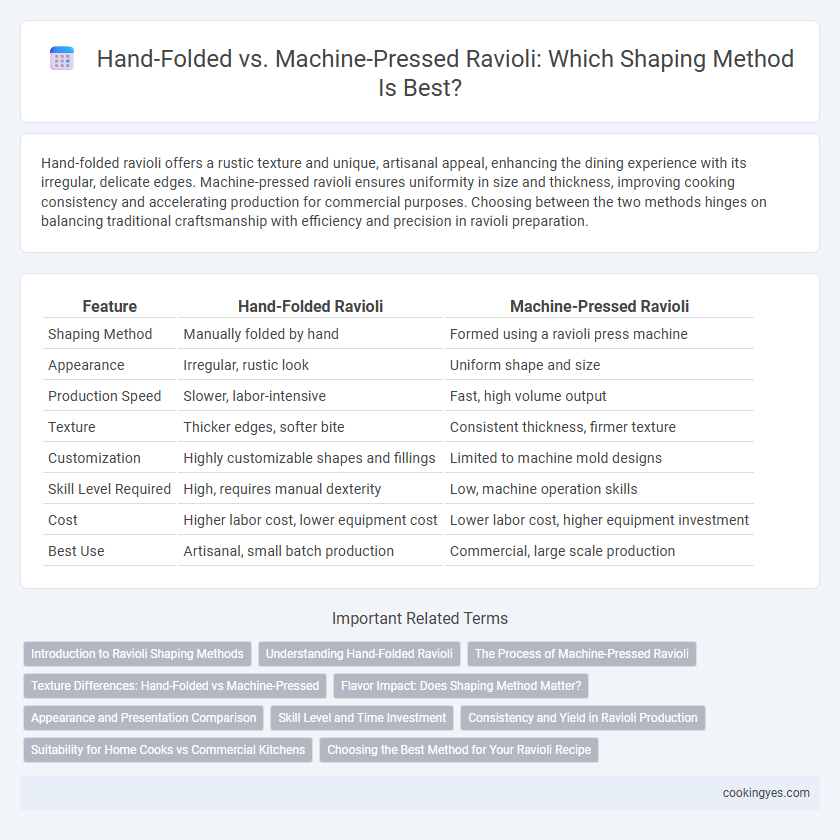Hand-folded ravioli offers a rustic texture and unique, artisanal appeal, enhancing the dining experience with its irregular, delicate edges. Machine-pressed ravioli ensures uniformity in size and thickness, improving cooking consistency and accelerating production for commercial purposes. Choosing between the two methods hinges on balancing traditional craftsmanship with efficiency and precision in ravioli preparation.
Table of Comparison
| Feature | Hand-Folded Ravioli | Machine-Pressed Ravioli |
|---|---|---|
| Shaping Method | Manually folded by hand | Formed using a ravioli press machine |
| Appearance | Irregular, rustic look | Uniform shape and size |
| Production Speed | Slower, labor-intensive | Fast, high volume output |
| Texture | Thicker edges, softer bite | Consistent thickness, firmer texture |
| Customization | Highly customizable shapes and fillings | Limited to machine mold designs |
| Skill Level Required | High, requires manual dexterity | Low, machine operation skills |
| Cost | Higher labor cost, lower equipment cost | Lower labor cost, higher equipment investment |
| Best Use | Artisanal, small batch production | Commercial, large scale production |
Introduction to Ravioli Shaping Methods
Hand-folded ravioli offers artisanal texture and intricate shaping, emphasizing craftsmanship and traditional techniques. Machine-pressed ravioli ensures uniform size and increased production efficiency, ideal for commercial-scale preparation. Both methods significantly influence dough thickness and filling distribution, impacting the final taste and presentation.
Understanding Hand-Folded Ravioli
Hand-folded ravioli offers artisanal quality by allowing precise control over dough thickness and filling distribution, resulting in a tender texture and enhanced flavor fusion. The traditional technique preserves irregular edges and slight variations that contribute to a rustic, authentic appearance and mouthfeel. This method also enables customization of shape and size, reflecting culinary craftsmanship unattainable through machine-pressed ravioli production.
The Process of Machine-Pressed Ravioli
Machine-pressed ravioli shaping involves feeding dough sheets and filling into a specialized machine that efficiently molds and seals each piece with consistent size and shape. The process significantly reduces production time while maintaining uniformity, making it ideal for commercial-scale ravioli manufacturing. Precision cutting blades and pressure settings ensure a tight seal to prevent filling leakage during cooking.
Texture Differences: Hand-Folded vs Machine-Pressed
Hand-folded ravioli exhibit a tender, artisanal texture with slightly uneven edges that enhance bite complexity, preserving a delicate dough softness. Machine-pressed ravioli offer a uniform, denser texture with precise sealing that ensures consistent cooking but can result in a firmer bite. Texture differences impact the overall mouthfeel, with hand-folded ravioli favoring a rustic experience and machine-pressed ravioli emphasizing efficiency and consistency.
Flavor Impact: Does Shaping Method Matter?
Hand-folded ravioli typically offers a more delicate texture and allows for varied thickness in the pasta, which can enhance the flavor by providing pockets that better hold sauces and fillings. Machine-pressed ravioli ensures uniform thickness and seals, potentially improving consistency in cooking but sometimes compromising the tender texture that influences flavor perception. The shaping method impacts the overall taste experience by affecting the balance between pasta and filling, with hand-folded ravioli often delivering a more artisanal, flavorful bite.
Appearance and Presentation Comparison
Hand-folded ravioli exhibit a rustic, artisanal appearance with irregular edges that emphasize craftsmanship, often appealing to gourmet presentations. Machine-pressed ravioli display uniform, precise shapes with consistent crimping, enhancing visual symmetry ideal for commercial and restaurant plating. The choice between hand-folded and machine-pressed ravioli significantly impacts the overall aesthetic, influencing customer perception and presentation style.
Skill Level and Time Investment
Hand-folded ravioli showcases artisanal skill, requiring steady precision and advanced craftsmanship to seal perfectly shaped pockets, making it ideal for experienced cooks. This method demands significant time investment, often doubling the preparation duration compared to machine-pressed ravioli, which streamlines the process with consistent pressure and uniform shapes, suitable for beginners or high-volume production. Machine pressing reduces manual effort and speeds up shaping, but may sacrifice some textural uniqueness and the personal touch evident in hand-crafted ravioli.
Consistency and Yield in Ravioli Production
Hand-folded ravioli offers artisanal texture and unique shapes but often results in variable consistency and lower yield due to irregular sizes and manual labor intensity. Machine-pressed ravioli ensures uniform thickness and edge sealing, significantly enhancing production consistency and maximizing yield by minimizing dough waste and streamlining the shaping process. Industrial ravioli producers favor machine pressing for scalable output and reliable product standards in high-volume environments.
Suitability for Home Cooks vs Commercial Kitchens
Hand-folded ravioli offers home cooks precise control over filling placement and customization, ideal for small batches and artisanal quality. Machine-pressed ravioli suits commercial kitchens by enabling high-volume production with uniform shapes and faster processing times. The choice depends on balancing quality and efficiency according to kitchen scale and skill level.
Choosing the Best Method for Your Ravioli Recipe
Hand-folded ravioli offers artisanal texture and a rustic appearance, enhancing flavors with a delicate, chewy dough that better retains fillings like ricotta or meat blends. Machine-pressed ravioli ensures uniform size and thickness, increasing cooking consistency and efficiency for large batches, ideal for recipes requiring precise portions or firmer dough. Selecting between these methods depends on desired presentation, production scale, and filling type, balancing craftsmanship with practicality for optimal ravioli quality.
Hand-folded vs machine-pressed for ravioli shaping Infographic

 cookingyes.com
cookingyes.com